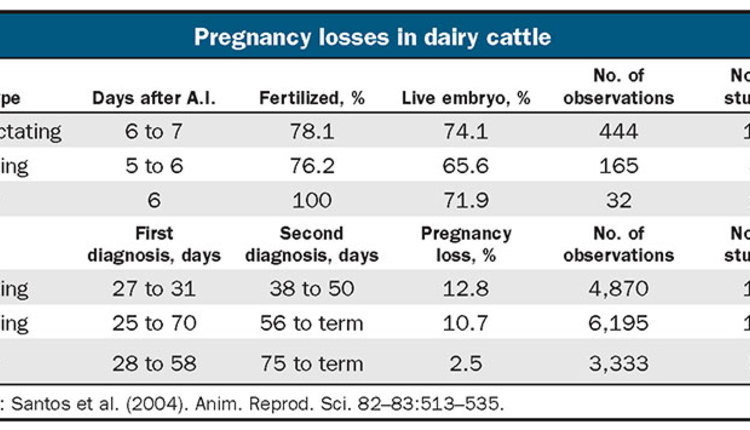The author is a professor of animal sciences and industry at Kansas State University, Manhattan.
 JeffStevenson
JeffStevensonIn the field of animal sciences, reproductive physiology began with early published studies of Sir John Hammond, who lived from 1889 to 1964. He was a physiologist, agricultural research scientist, and veterinarian who provided pioneering work in artificial insemination.
Other information followed, such as the classic 1940’s publication of the late George Trimberger, which provided scientific basis for the AM-PM rule for A.I. breeding. Many other basic foundation principles were discovered before 1980 upon which was built our understanding of reproductive management of the estrous cycle.
It’s a foundation
Reproduction is a key element to the success and sustainability of every modern dairy today. Regardless of how well cows are fed, housed, and milked, if cows do not calve regularly, the herd cannot sustain itself. The management of Hoard’s Dairyman recognized this important principle when they engaged Harold Hafs and Louis Boyd to author the first edition of what is now known as the Dairy Cattle Fertility book in 1964. This first edition provided sound principles and management practices that have assisted students and practitioners in the dairy industry for decades.
A 1996 revision was organized by Ray Nebel, who now serves as a reproduction solution specialist for Select Sires. W.S. Swecker, of the Virginia-Maryland College of Veterinary Medicine, and myself assisted Nebel with that updated edition. Hoard’s Dairyman then partnered with the Dairy Cattle Reproduction Council (DCRC) for the 2007 update of the book, led again by Nebel and Ellen Jordan of Texas A&M University.
The most current 2020 edition of Dairy Cattle Fertility is now available for purchase. The 19 chapters were written by industry-leading authors, and its contents will be of great value to any student of the dairy sciences.
A preview
Chapter 1 covers the potential economic losses resulting from mismanagement of reproduction. It discusses the costs of infertility, the importance of timely pregnancy creation, measures of reproductive efficiency and profitability, and how milk price relates to 21-day pregnancy risk. Chapters 2 and 3 contain detailed illustrations of the bull’s and cow’s reproductive anatomy and discusses their functions.
Chapter 4 highlights the mechanisms that control reproductive processes in the cow and heifer, including a glossary of terms for the novice reader. Chapter 5 relates how the sperm meets the egg to form a new embryo and also what things can go awry because of environmental conditions and genetic defects.
In Chapter 6, the genetics of fertility are presented, including genetic defects that have been discovered. It also explains those quantitative reproductive traits that are included in genetic evaluations and how changes in selection indexes have increased breeding values resulting in improved fertility during the last decade. Chapter 7 reviews diseases that are associated with reproductive losses and how disease can be reduced by appropriate vaccination programs and general hygiene.
Chapter 8 reviews the period of embryo and calf development that occurs in utero and how pregnancy is recognized and maintained until calving time. Chapter 9 discusses the calving process, how to recognize the stages of parturition, how to know when to provide proper calving assistance, and other principles of maternity management of mother and newborn. Chapter 10 covers the health of fresh cows including management and prevention of various metabolic diseases and disorders that affect cows at calving.
Chapter 11 reviews postpartum changes in the cow’s reproductive tract and ovarian function in preparation for first A.I. breeding and establishment of a new pregnancy. A discussion of the voluntary waiting period is also presented. Chapter 12 covers all aspects of the A.I. program including semen handling and storage, hygiene, insemination techniques, and semen placement to maximize pregnancy outcome.
Chapters 13 and 14 describe up-to-date successful fertility programs (estrus and ovulation synchronization programs) for both lactating dairy cows and replacement heifers, respectively. Chapter 15 reviews the current methods for diagnosing pregnancy that include both palpation and chemical tests for early detection of pregnancy.
Chapter 16 summarizes the reproductive technologies available to dairy producers to monitor health and detect estrus in addition to sexed semen uses and other assisted reproductive technologies for embryo production and transfer. Chapter 17 provides some invaluable tips for troubleshooting reproductive problems and recommendations for fine-tuning your reproductive program.
Chapter 18 reviews the principles for using bulls on the farm including both the advantages and disadvantages of that choice. Last, but not least, Chapter 19 reviews feeding tips for improved fertility. It presents a very nice review of all the essential nutrients for lactating and dry cow feeding programs.
A strong foundation
At the end of most chapters, a “Read More About It” section provides additional resources for the reader. Where we are today depends on current and past research efforts of animal scientists because we are “standing on the shoulders of giants.” Happy A.I. breeding!









